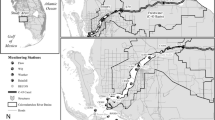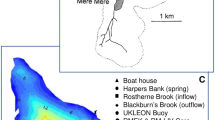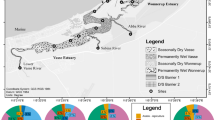Abstract
Nitrogen inputs to Great Salt Lake (GSL), located in the western USA, were quantified relative to the resident nitrogen mass in order to better determine numeric nutrient criteria that may be considered at some point in the future. Total dissolved nitrogen inputs from four surface-water sources entering GSL were modeled during the 5-year study period (2010–2014) and ranged from 1.90 × 106 to 5.56 × 106 kg/year. The railroad causeway breach was a significant conduit for the export of dissolved nitrogen from Gilbert to Gunnison Bay, and in 2011 and 2012, net losses of total nitrogen mass from Gilbert Bay via the Causeway breach were 9.59 × 105 and 1.51 × 106 kg. Atmospheric deposition (wet + dry) was a significant source of nitrogen to Gilbert Bay, exceeding the dissolved nitrogen load contributed via the Farmington Bay causeway surface-water input by >100,000 kg during 2 years of the study. Closure of two railroad causeway culverts in 2012 and 2013 likely initiated a decreasing trend in the volume of the higher density Deep Brine Layer and associated declines in total dissolved nitrogen mass contained in this layer. The large dissolved nitrogen pool in Gilbert Bay relative to the amount of nitrogen contributed by surface-water inflow sources is consistent with the terminal nature of GSL and the predominance of internal nutrient cycling. The opening of the new railroad causeway breach in 2016 will likely facilitate more efficient bidirectional flow between Gilbert and Gunnison Bays, resulting in potentially substantial changes in nutrient pools within GSL.








Similar content being viewed by others
References
Aldrich TW, Paul DS (2002) Avian ecology of Great Salt Lake. In: Gwynn JW (ed) Great Salt Lake: an overview of change. Utah Department of Natural Resources Special Publication, Salt Lake City, pp 343–374
Baskin RL (2005) Calculation of area and volume for the south part of Great Salt Lake, Utah. U.S. Geological Survey Open-File Report 2005-1327
Baskin RL (2006) Calculation of area and volume for the north part of Great Salt Lake, Utah. U.S. Geological Survey Open-File Report 2006-1359
Belovsky GE, Stephens D, Perschon C, Birdsey P, Paul D, Naftz D, Baskin R, Larson C, Mellison C, Luft J, Mosley R, Mahon H, Van Leeuwen J, Allen D (2011) The Great Salt Lake Ecosystem (Utah, USA): long term data and a structural equation approach. Ecosphere. doi:10.1890/ES10-00091.1
Buchanan TJ, Somers WP (1968) Stage measurements at gaging stations. U.S. Geological Survey Techniques of Water-Resources Investigations. Book 3, Chap. A7, p 28
Buchanan TJ, Somers WP (1969) Discharge measurements at gaging stations. U.S. Geological Survey Techniques of Water-Resources Investigations. Book 3, Chap. A8, p 65
Carter RW, Davidian J (1968) General procedure for gaging streams. U.S. Geological Survey Techniques of Water-Resources Investigations. Book 3, Chap. A6, p 13
Cohn TA (1988) Adjusted maximum likelihood estimation of the moments of lognormal populations from type I censored samples. U.S. Geological Survey Open-File Report 88-350
Cohn TA, Gilroy EJ, Baier WG (1992) Estimating fluvial transport of trace constituents using a regression model with data subject to censoring. In: Proceedings of the joint statistical meeting. Boston, Massachusetts, USA, August 9–13, 1992, pp 142–151
Galat DL (1990) Seasonal and long-term trends in Truckee River nutrient concentrations and loadings to Pyramid Lake, Nevada: a terminal saline lake. Water Res 24:1031–1040
Isaacson AE, Hachman FC, Robson RT (2002) The economics of Great Salt Lake. In: Gwynn JW (ed) Great Salt Lake: an overview of change. Utah Department of Natural Resources Special Publication, Salt Lake City, pp 187–200
Jellison R, Melack JM (1993) Algal photosynthetic activity and its response to meromixis in hypersaline Mono Lake, California. Limnol Oceanogr 38:818–837
Jellison R, Miller LG, Melack JM, Dana GL (1993) Meromixis in hypersaline Mono Lake, California. 2. Nitrogen fluxes. Limnol Oceanogr 38:1020–1039
Judge GG, Hill RC, Griffiths WE, Lutkepohl H, Lee TC (1988) Introduction to the theory and practice of econometrics, 2nd edn. Wiley, New York
Loving BL, Waddell KM, Miller CW (2000) Water and salt balance of Great Salt Lake, Utah, and simulation of water and salt movement through the causeway, 1987–1998. U.S. Geological Survey water-resources investigations report 00-4221
Marcarelli AM, Wurtsbaugh WA, Griset O (2006) Salinity controls phytoplankton response to nutrient enrichment in Great Salt Lake, Utah, USA. Can J Fish Aquat Sci 63:2236–2248
Naftz DL, Johnson WP, Freeman ML, Beisner K, Diaz X, Cross VA (2009) Estimation of selenium loads entering the south arm of Great Salt Lake, Utah, from May 2006 through March 2008. U.S. Geological Survey scientific investigations report 2008-5069
Naftz DL, Carling GT, Angeroth C, Freeman M, Rowland R, Pazmiño E (2014) Density-stratified flow events in Great Salt Lake, Utah, USA: implications for mercury and salinity cycling. Aquat Geochem 20:547–571
Nash JE, Sutcliffe JV (1970) River flow forecasting through conceptual models part I—a discussion of principles. J Hydrol 10:282–290
National Atmospheric Deposition Program (2017) Annual NTN maps by year. http://nadp.sws.uiuc.edu/NTN/annualmapsByYear.aspx. Accessed 4 Jan 2017
Patton CJ, Kryskalla JR (2003) Methods of analysis by the U.S. Geological Survey National Water Quality Laboratory—Evaluation of alkaline persulfate digestion as an alternative to Kjeldahl digestion for determination of total and dissolved nitrogen and phosphorus in water. U.S. Geological Survey water-resources investigation report 03-4174
Rodó X, Giralt S, Burjachs F, Comín FA, Tenorio RG, Julià R (2002) High-resolution saline lake sediments as enhanced tools for relating proxy paleolake records to recent climatic data series. Sediment Geol 148:203–220
Runkel RL (2013) Revisions to LOADEST, April 2013. http://water.usgs.gov/software/loadest/doc/ Accessed 12 Dec 2016
Runkel RL, Crawford CG, Cohn TA (2004) Load estimator (LOADEST): a FORTRAN program for estimating constituent loads in streams and rivers. U.S. Geological Survey techniques and methods, book 4, chap. A5, p 69
Salm CR, Saros JE, Fritz SC, Osburn CL, Reineke DM (2009) Phytoplankton productivity across prairie saline lakes of the Great Plains (USA): a step toward deciphering patterns through lake classification models. Can J Fish Aquat Sci 66:1435–1448
Salt Lake Tribune (2016) Crews breach Great Salt Lake causeway to restore balance of salt, water levels. http://www.sltrib.com/home/4664792-155/photos-crews-breach-great-salt-lake. Accessed 14 Feb 2017
Schwede DB, Lear GG (2014) A novel hybrid approach for estimating total deposition in the United States. Atmos Environ 92:207–220
Simpson MR (2001) Discharge measurements using a broad-band acoustic Doppler current profiler. U.S. Geological Survey open-file report 01-1
Stephens DW, Gillespie DM (1976) Phytoplankton production in the Great Salt Lake, Utah, and a laboratory study of algal response to enrichment. Limnol Oceanogr 21:74–87
Sturm PA (1980) The Great Salt Lake brine system. In: Gwynn JW (ed) Great Salt Lake: a scientific, historical, and economic overview, vol 116. Utah Department of Natural Resources Bulletin, Salt Lake City, pp 147–162
U.S. Geological Survey (2017) Inorganic blind sample project: current and historical performance chart and data access. https://bqs.usgs.gov/ibsp/charts.php. Accessed 18 May 2017
U.S. Geological Survey (variously dated) National field manual for the collection of water-quality data. U.S. Geological Survey Techniques of Water-Resources Investigations, book 9, chaps. A1–A10. http://pubs.water.usgs.gov/twri9A. Accessed 7 Nov 2016
Utah Department of Environmental Quality (2016) Final integrated report, version 2.1. http://www.deq.utah.gov/ProgramsServices/programs/water/wqmanagement/assessment/currentIR2016.htm. Accessed 15 Feb 2017
Wilde FD, Radtke DB, Gibs J, Iwatsubo RT (1999) Collection of water samples. U.S. Geological Survey techniques of water-resources investigations, book 9, chap. A4. http://pubs.water.usgs.gov/twri9A4/. Accessed 27 Apr 2006
William WD (2002) Environmental threats to salt lakes and the likely status of inland saline ecosystems in 2025. Environ Conserv 29:154–167. doi:10.1017/S0376892902000103
Williams WD (1981) Inland salt lakes: an introduction. Hydrobiologia 81–82:1–14. doi:10.1007/BF00048701
Wurstbaugh W, Naftz DL, Bradt S (2009) Eutrophication, nutrient fluxes and connectivity between the bays of Great Salt Lake, Utah (abs.). In: Oren A, Naftz D, Palacios P, Wurtsbaugh WA (eds) Saline lakes around the world: unique systems with unique values, natural resources and environmental issues, vol XV. S.J. and Jessie E. Quinney Natural Resources Research Library, Logan, p 51
Wurtsbaugh WA (1988) Iron, molybdenum and phosphorus limitation of N2 fixation maintains nitrogen deficiency of plankton in the Great Salt Lake drainage (Utah, USA). Verh Int Ver Limnol 23:121–130
Wurtsbaugh WA (2014) Management of the Great Salt Lake ecosystem: water, economic values and competing interests. Utah State University Watershed Sciences Faculty Publications. Paper 594. http://digitalcommons.usu.edu/wats_facpub/594. Accessed 16 Feb 2017
Wurtsbaugh WA, Gliwicz ZM (2001) Limnological control of brine shrimp population dynamics and cyst production in the Great Salt Lake, Utah. Hydrobiologia 466:119–132
Wurtsbaugh W, Marcarelli A (2006) Eutrophication in Farmington Bay, Great Salt Lake, Utah 2005 annual report. Watershed Sciences Faculty Publications. Paper 560. http://digitalcommons.usu.edu/wats_facpub/560. Accessed 16 Feb 2017
Zeinoddini M, Tofighi MA, Vafaee F (2009) Evaluation of dike-type causeway impacts on the flow and salinity regimes in Urmia Lake, Iran. J Great Lakes Res 35:13–22
Acknowledgements
Any use of trade, firm, or product names is for descriptive purposes only and does not imply endorsement by the U.S. Government or the State of Utah. Funding for this study was provided by the Utah Department of Natural Resources/Division of Wildlife Resources/Great Salt Lake Ecosystems Project and the USGS. The manuscript was improved significantly from technical reviews by Ryan Rowland (USGS), and two anonymous reviewers.
Author information
Authors and Affiliations
Corresponding author
Electronic supplementary material
Below is the link to the electronic supplementary material.
Rights and permissions
About this article
Cite this article
Naftz, D. Inputs and Internal Cycling of Nitrogen to a Causeway Influenced, Hypersaline Lake, Great Salt Lake, Utah, USA. Aquat Geochem 23, 199–216 (2017). https://doi.org/10.1007/s10498-017-9318-6
Received:
Accepted:
Published:
Issue Date:
DOI: https://doi.org/10.1007/s10498-017-9318-6




